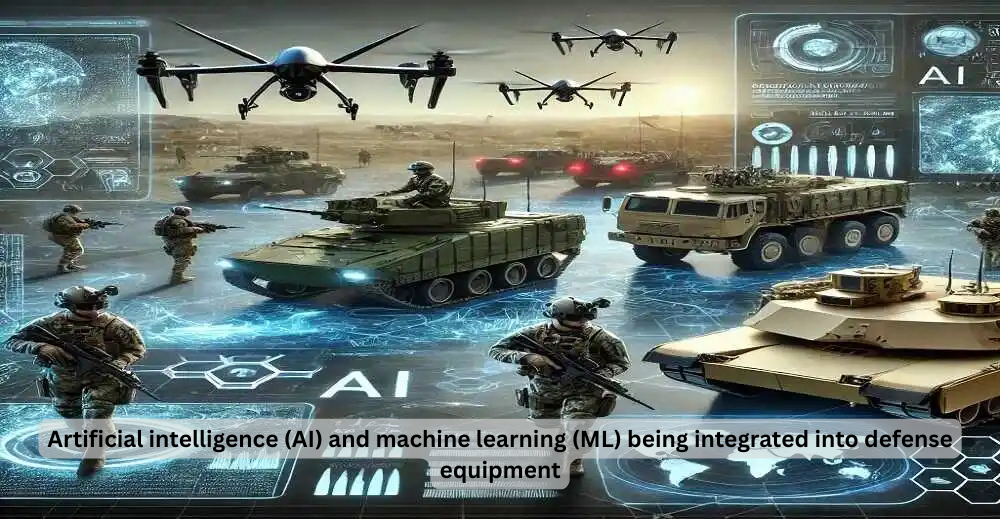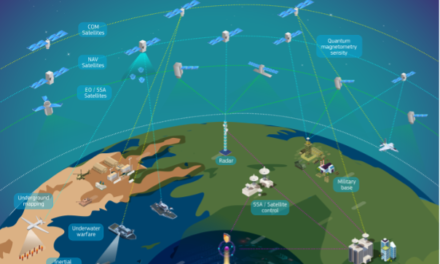Artificial intelligence (AI) and machine learning (ML) are being integrated into defense equipment to enhance efficiency, accuracy, decision-making, and operational capabilities across various military domains. These technologies are transforming how defense systems operate, enabling greater autonomy, faster response times, and improved adaptability to complex and dynamic battlefield environments.
1. Key Applications of AI and ML in Defense Equipment
a. Autonomous Vehicles and Drones
- Unmanned Aerial Vehicles (UAVs):
- AI enables drones to perform autonomous navigation, surveillance, and strike missions with minimal human intervention.
- Example: MQ-9 Reaper with AI-driven target recognition systems.
- Unmanned Ground Vehicles (UGVs):
- AI allows UGVs to conduct reconnaissance, logistics, and combat support autonomously.
- Example: MAARS (Modular Advanced Armed Robotic System) for tactical operations.
- Unmanned Underwater Vehicles (UUVs):
- AI helps UUVs perform underwater reconnaissance, mine detection, and surveillance missions.
- Example: REMUS series of autonomous underwater vehicles.
b. Intelligence, Surveillance, and Reconnaissance (ISR)
- Data Analysis:
- AI processes data from satellites, drones, and ground sensors to identify patterns, classify objects, and detect anomalies.
- Example: AI-powered SAR (Synthetic Aperture Radar) systems for high-resolution imagery analysis.
- Real-Time Threat Detection:
- AI detects and tracks potential threats, such as enemy vehicles, aircraft, or personnel, in real time.
- Example: Project Maven processes video feeds from drones to identify hostile activities.
c. Command and Control (C2) Systems
- Automated Decision Support:
- AI analyzes battlefield data to recommend optimal strategies, resource allocation, and mission planning.
- Example: DARPA’s Mosaic Warfare concept uses AI for decentralized command.
- Predictive Analysis:
- ML models predict enemy movements, resource needs, and equipment failures, improving operational readiness.
d. Cybersecurity and Electronic Warfare
- Threat Detection:
- AI identifies and mitigates cyber threats, including malware, phishing, and denial-of-service attacks.
- Example: AI-driven intrusion detection systems for military networks.
- Electronic Countermeasures:
- AI enhances jamming, spoofing, and radar deception capabilities to disrupt enemy communications and targeting.
e. Target Recognition and Precision Strike
- Automated Targeting:
- AI enables precision targeting by identifying, tracking, and engaging enemy assets with minimal collateral damage.
- Example: AI-powered munitions like loitering drones (e.g., Harop) that autonomously identify and strike targets.
- Smart Munitions:
- AI optimizes flight paths and impact points for guided weapons.
- Example: Advanced artillery shells with AI-guided targeting.
f. Training and Simulation
- Realistic Training Scenarios:
- AI-driven simulations create dynamic, adaptive training environments for soldiers, pilots, and commanders.
- Example: Virtual Reality (VR) platforms powered by AI to simulate battlefield conditions.
- AI-Generated Opponents:
- Simulates realistic adversary behaviors for training exercises.
g. Logistics and Maintenance
- Predictive Maintenance:
- ML models analyze sensor data from vehicles, aircraft, and ships to predict component failures and optimize maintenance schedules.
- Example: AI systems on F-35 aircraft monitor engine performance to predict malfunctions.
- Autonomous Supply Chains:
- AI coordinates logistics, ensuring timely delivery of supplies and equipment to combat zones.
h. Situational Awareness and Decision-Making
- Battlefield Analytics:
- AI integrates data from multiple sources, such as satellites, drones, and soldiers, to provide a unified operational picture.
- Example: IBM Watson’s AI applied to military intelligence.
- Multi-Domain Operations:
- AI synchronizes operations across land, sea, air, space, and cyber domains.
2. Emerging Technologies Enabled by AI and ML
a. Swarm Intelligence
- AI coordinates large numbers of drones or robots to operate as a swarm, performing tasks like reconnaissance, area denial, or attack.
- Example: DARPA’s OFFSET program for drone swarms.
b. Cognitive Electronic Warfare
- AI-driven systems adapt to enemy electronic warfare tactics in real time, ensuring continued operational effectiveness.
- Example: Cognitive radar that changes frequencies to evade jamming.
c. Quantum AI
- Combines quantum computing with AI to process vast amounts of battlefield data quickly, enhancing decision-making and cryptography.
d. Human-Machine Teaming
- AI enhances the capabilities of soldiers by providing decision support, managing drones, or controlling autonomous vehicles.
- Example: AI copilots in military aircraft assisting human pilots.
e. Hypersonic Defense
- AI tracks and predicts the trajectory of hypersonic missiles for effective interception.
- Example: AI-powered radar systems for real-time tracking.
3. Benefits of AI and ML Integration
a. Faster Decision-Making
- Reduces human reaction times by processing and analyzing data at speeds far beyond human capabilities.
b. Enhanced Precision and Accuracy
- Minimizes collateral damage and increases mission success rates through precise targeting and planning.
c. Reduced Risk to Personnel
- Autonomous systems perform high-risk tasks, such as demining or reconnaissance in hostile environments.
d. Increased Operational Efficiency
- Optimizes resource allocation, logistics, and mission execution through predictive analytics and automation.
e. Adaptability to Dynamic Threats
- AI learns and adapts to new tactics, ensuring continued relevance in evolving conflict scenarios.
4. Challenges and Solutions
a. Ethical Concerns
- Challenge:
- Potential misuse of autonomous weapons and lack of accountability.
- Solution:
- Develop international frameworks for ethical AI use in defense.
b. Reliability and Trust
- Challenge:
- Ensuring AI systems perform reliably in unpredictable environments.
- Solution:
- Rigorous testing and incorporating human oversight in critical decisions.
c. Vulnerability to Cyberattacks
- Challenge:
- AI systems may be targeted for hacking or spoofing.
- Solution:
- Implement robust cybersecurity measures and secure AI training data.
d. Data Dependency
- Challenge:
- AI systems require vast amounts of high-quality data for training.
- Solution:
- Use synthetic data and real-world operational data for comprehensive training.
5. Real-World Examples of AI in Defense
- Project Maven (USA):
- AI processes drone video footage to identify targets.
- Loyal Wingman Program (Australia):
- AI-powered drones operate alongside manned aircraft to perform reconnaissance and strike missions.
- Iron Dome (Israel):
- AI calculates intercept trajectories for incoming missiles.
- Perdix Drone Swarms (USA):
- AI-controlled drones operate as a coordinated swarm for reconnaissance and attack.
6. Strategic Importance
- Force Multiplication:
- Enhances the capabilities of limited personnel and equipment.
- Information Dominance:
- Provides superior intelligence and decision-making capabilities.
- Asymmetric Advantage:
- Counteracts larger or more technologically advanced adversaries through innovative applications.
Conclusion
AI and ML are revolutionizing defense equipment by enabling greater autonomy, precision, and adaptability. From autonomous drones and predictive maintenance to battlefield analytics and swarm intelligence, these technologies are shaping the future of military operations. As the integration of AI advances, ensuring ethical use, reliability, and resilience will be crucial for maintaining strategic and operational superiority.
Hashtags
#AIInDefense #MLInMilitaryTech #SmartDefenseTech #AIForDefense #MachineLearningInDefense #AutonomousDefenseSystems #AIInAutonomousVehicles #SmartMilitaryRobots #AIInWarfareTech #RoboticsInDefense #AIForISR #SmartSurveillance #AIInReconnaissance #IntelligentMonitoringSystems #AIForCommandAndControl #MLInBattlefieldManagement













